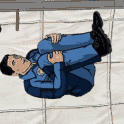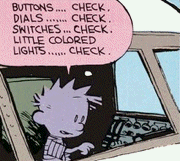|
The Slaughter posted:http://www.avweb.com/avwebflash/news/Gun-Toting-FAA-Inspector-Nabbed-At-LaGuardia223415-1.html And of course he only gets a slap on the wrist paid vacation.
|
|
|
|

|
| # ? May 8, 2024 16:46 |
|
avweb article posted:It offered no explanation as to why the inspector might have been packing. Well, going from one war zone to another will have that effect.
|
|
|
|
Anybody have experience doing a rotorcraft add-on after they already had a commercial pilots license? I'm wondering what the real world hour figures would be.
|
|
|
|
Here's a cool video. https://www.youtube.com/watch?v=lP35ULU6IcQ
|
|
|
|
Captain Apollo posted:Anybody have experience doing a rotorcraft add-on after they already had a commercial pilots license? before or after you die in the deathtraps that are light helicopters?
|
|
|
|
The Slaughter posted:before or after you die in the deathtraps that are light helicopters? Well I'd like the license before I died... So - before?
|
|
|
|
I just got a part-time job on the side as an instrument instructor. I've had my II for over a year now and I've never actually used it, plus my instrument instructor was a joke and I want to avoid putting someone else through that. What's a good jumping off point for me? Anyone have a good instrument syllabus they use, or should I just chug through the PTS? Basically, I don't want to wing it and look like I'm new to instructing.
|
|
|
|
Rolo posted:I just got a part-time job on the side as an instrument instructor. I've had my II for over a year now and I've never actually used it, plus my instrument instructor was a joke and I want to avoid putting someone else through that. What's a good jumping off point for me? Anyone have a good instrument syllabus they use, or should I just chug through the PTS? Do you have some kind of loggable sim available to you? I would start students off in that to save them money and time before jumping in to a real plane.
|
|
|
|
I have a great syllabus I like to use but it's really all based on King schools and the Cessna program. I'm a believer in their stuff.
|
|
|
|
e.pilot posted:Do you have some kind of loggable sim available to you? I would start students off in that to save them money and time before jumping in to a real plane. I do have access to one, so there's a thought.
|
|
|
|
I have a glaringly large bias, but we pretty much built PilotEdge with instrument students and their instructors in mind, and have a list of testimonials from instrument students a mile long that all say they feel it was a major factor in their success in getting their ticket. Especially if you have ready access to a loggable sim, you should check it out. There is a whole series of IFR training ratings that step through progressively more complicated IFR flights. As the instructor, you can easily review flight records and listen to your students' audio recordings, with the silences removed for easy analysis. We're also working on a lot more CFI(I)-focused features. OK, end commercial 
|
|
|
|
Sim time is such a great asset to IFR training. I got 40 hours of IFR sim time through my college and it was priceless. A bit of a learning curve going from the Frasca 141 to a real plane, but I was able to earn my ticket at minimums.
|
|
|
|
Started ground school today and I'm already  at the amount of stuff we cover in the next 6 weeks at the amount of stuff we cover in the next 6 weeks
|
|
|
|
Butt Reactor posted:Started ground school today and I'm already For ppl?
|
|
|
|
Butt Reactor posted:Started ground school today and I'm already During indoc you can pay half attention and get working on the stuff you'll need for systems (assuming SKW training isn't all CBT-based): • Buy note cards and start making limitation/memory item flashcards. You'll become casually familiar with the limits and will start the process of memorizing while creating them. • Mount the cockpit poster in your hotel room and refer to it constantly when you're going over systems, limits, memory items. Verbalize stuff (even if you're by yourself) to get used to coherently elocuting things like you will in the oral. When you get to systems: • Find the dude or dudette in your class that annoys you the least and try to pair up for study sessions and stump-the-dummy (systems, limits and memory items). Be brutal in your corrections and use the SPECIFIC LANGUAGE the manufacturer uses. If they call the fuel switch a cock, you call the fuel switch a cock. #1 and #2 vs left and right? This poo poo matters. • Run your limitation/MI flash cards several times a day including as soon as you wake up and just before you hit the sack. Make sure you have these down - cold - before you start sims. Some airlines do the FO oral after systems and before sims, but I think this is cruel. How the gently caress are you supposed to really understand a system you've never seen operate? • You'll want a comfortable understanding of the aircraft systems, but if your instructors tell you you don't need to know so much about them - listen. I always felt that going just a little deeper into the systems than they covered in class got me super-prepared for any oral. About 5% over. I'm typically paranoid and have a tendency to over prepare for aircraft training, a trait that exists in no other place in my life. • Don't over prepare for the oral in one area at the expense of any others. I was bulletproof in systems knowledge in the ATR prior to my oral at Eagle a million years ago, but was clueless when it came to cold weather ops and the retardedly anal procedures that entailed. I busted my initial oral as a result. I spent one solid day getting ready for the retest and the examiner asked me WTF happened in the first one. I had to admit that I wasn't fully prepared and that I wouldn't ever let that happen again. I haven't. During sims: • Unless your sims are at o-dark 30 (in which case you do it the night before), review the poo poo out of the day's sim syllabus and go through EVERY ONE of the failures/procedures you're going to cover with your sim partner. If you're paired with a Captain upgrade who came from the same fleet and doesn't want to get this deep into it - do it yourself. Read the QRH, verbalize any memory items and limits associated with the checklist and know what you should be doing if you get that specific failure. If you're on fire, be heading in the direction of an airport that satisfies the closest time-in-place requirement. If you have a flap malfunction while on approach, go around and deal with the problem at your leisure as long as you have the fuel. Having said that, be aware of your fuel state. Don't end up like United 173. • Get a lot of sleep. This is hard work both mentally and physically. If you have enough time to just walk around for 20-30 minutes outside or run on the treadmill for half a Sports Center, do it. • Know the phase of flight profiles - cold. Approach flaps outside the marker or FAF, gear down at 1-dot, final flaps at GS intercept, before landing check... whatever. You'll probably be fed the stall profile every time you have a chance to do it, but the ILS, non precision approach and visual landing profiles get used EVERY TIME. During IOE: • You will probably not have an engine failure or fire during IOE, but you will do a shitload of W&B forms/calculations. Time to get back in the Ops Manual and become familiar with all the stuff you do on a normal day. • Wear the uniform the way the company wants you to - yeah, even the hat. Your IOE Captain might not give a poo poo, but somebody who sees you during IOE/probation might. Save the individualism for when you're off probation. When you're off IOE: • Be an information sponge. Seek help with position and line bidding. Find out who the dumb asses are and avoid them. Keep your cards close to your vest when it comes to controversial stuff. It's not as bad as being in prison, but close. You won't have to beat somebody up the first day. • Be somewhat reserved around Flight Attendants. Don't get your meat where you get your bread. NEVER have a conversation with a FA about anything discipline-related unless you have another pilot with you. Seriously. • If you commute, don't be a dick while jumpseating. It is not yours - ask the Captain for a ride. • Be extremely careful who you allow to access your pass benefits. Your cousin can act like a total jackass on your buddy pass and completely gently caress up your access to that benefit (which, admittedly, isn't worth what it once was). • Start contributing as much as possible to your 401k. Barring major calamity, I'm going to retire very comfortably when I'm 57-60 because I contributed until it hurt when I was making $16k per year at a commuter. Good luck. Go forth and prosper.
|
|
|
|
Question I went to get cleared up as I get closer to finishing IFR (one of many questions I'm sure I'll bring here). Take the KGED VOR 4 approach : http://skyvector.com/files/tpp/1501/pdf/00935V4.PDF I'm putting along from the NW, flying SE bound, and arrive at LAURY IAF. I fly direct to the waypoint, and turn right to track 233 outbound for a minute before making a >180 turn to track 053 inbound to the fix - aka a parallel entry. I arrive, again, at LAURY, now: do I depart LAURY heading 053 on the approach, having done my course reversal OR do I then turn left to track 233 and fly the entire racetrack before proceeding? My instructor said once I do the course reversal and I'm on 053 inbound to the fix, even without having done the full racetrack yet, I can just proceed inbound. Just want to confirm this is correct?
|
|
|
|
Rickety Cricket posted:Question I went to get cleared up as I get closer to finishing IFR (one of many questions I'm sure I'll bring here). The hold entry maneuver counts as your course reversal, you can proceed inbound after your hold entry maneuver. EDIT: From the FAA Instrument Procedures Handbook, p. 5-39 quote:The 45° procedure turn, the racetrack pattern (holding The Ferret King fucked around with this message at 00:21 on Jan 28, 2015 |
|
|
Butt Reactor posted:Started ground school today and I'm already To emphasize what ausgezeichnet said: -Start memorizing limitations and memory items early. If you do a few minutes per day, every day, for the duration of your ground school it'll lessen the load a lot. -Be specific with your numbers, callouts, and ver bage. Example: Do you need anti-ice when it's 10 degrees TAT or do you need it when it's BELOW 10 degrees TAT? -Know your flows BEFORE you get into the sim -"chair fly" everything you are going to do that day once you get to the sim. ESPECIALLY things like go arounds and v1 cuts. For systems I've found that just looking at the overhead panel helps greatly to guide your system studying. If you can look at a switch and explain what it does when pushed in, what it does when pushed out, what are any limitations associated with it, what memory items/checklists are associated with it, and what will cause any of the lights in the switch to come on. Oh and if you end up on the CRJ remember to apologize to the ATC guys in here whenever you fly a 100/200.
|
|
|
|
|
Yeah, poo poo. I forgot about flows. Flows should be on your plate toward the end of systems, but before you get to the sim. If you have a break between those portions, it's good to use flash cards for flows, too and to run them by pointing at stuff on the overhead panel poster. If you have access to a procedures trainer at the schoolhouse (ie, paper trainer), use that to put the flows in memory. Some people like to create acronyms to remember flows, but I prefer remembering how MANY items there are on a flow and using muscle memory to know what to reach for.KodiakRS posted:For systems I've found that just looking at the overhead panel helps greatly to guide your system studying. If you can look at a switch and explain what it does when pushed in, what it does when pushed out, what are any limitations associated with it, what memory items/checklists are associated with it, and what will cause any of the lights in the switch to come on. For reals.
|
|
|
|
Hopefully your company has touch screen cockpit trainers, that helped me a lot. Even the paper tigers help a lot for flows
|
|
|
|
KodiakRS posted:To emphasize what ausgezeichnet said: This. In addition to what's been said already, I'd add that flows are best learned (initially) by rote memorization, without trying to understand exactly why you're doing something until that system comes up in ground school or you have some other compelling reason to know that information. When I got my Q400 type rating, I initially learned the flows by rote-memorizing each step and where my hands were going for each flow, without worrying about why I was pressing any given button on a flow. The person who struggled in my class spent way too much time initially trying to figure out why certain things were done on the flows, instead of just getting the proper steps committed to memory first and letting the details get filled in as ground school progressed.
|
|
|
|
ausgezeichnet posted:drat good advice Some questions up for anyone who wants to answer: quote:• Wear the uniform the way the company wants you to - yeah, even the hat. Your IOE Captain might not give a poo poo, but somebody who sees you during IOE/probation might. Save the individualism for when you're off probation. What's a good recommend on shoes? I don't think these will quite work but they've been so drat comfortable the past couple years I've worn them. At least I bought the cap and blazer and SKW is giving us a couple shirts/pants!  quote:• If you commute, don't be a dick while jumpseating. It is not yours - ask the Captain for a ride. quote:• Be extremely careful who you allow to access your pass benefits. Your cousin can act like a total jackass on your buddy pass and completely gently caress up your access to that benefit (which, admittedly, isn't worth what it once was). quote:• Be somewhat reserved around Flight Attendants. Don't get your meat where you get your bread. NEVER have a conversation with a FA about anything discipline-related unless you have another pilot with you. Seriously. Animal posted:Hopefully your company has touch screen cockpit trainers, that helped me a lot. Even the paper tigers help a lot for flows KodiakRS posted:Oh and if you end up on the CRJ remember to apologize to the ATC guys in here whenever you fly a 200. Hey we fly 7s and 9s too  Aren't you an RJ driver too? any pitfalls to watch for on the barbie jet? Aren't you an RJ driver too? any pitfalls to watch for on the barbie jet?And to Ferret King, fknlo, MrYenko, and every other ATC, goon or otherwise: I'm so sorry.
|
|
|
|
Fastest plane I've ever logged time in is a King Air. Tomorrow I'm flying a Lear 60. Plus it's my birthday.
|
|
|
|
quote:What's a good recommend on shoes? quote:I've heard commuting with certain...carriers...can be kinda painful since SKW is nonunion and everyone else is I work with a pilot group who generally hold a grudge against Skywest (a lot of people are still bitter that SKW "stole our jets" in 2011, and the recently announced routes/new jets for Alaska just added to that), but I've never seen a SKW pilot get denied a jumpseat, even by a captain who has several "FU Skabwest" stickers on their flight case.
|
|
|
Butt Reactor posted:What's a good recommend on shoes? I don't think these will quite work but they've been so drat comfortable the past couple years I've worn them. At least I bought the cap and blazer and SKW is giving us a couple shirts/pants! I don't know how picky SKW is about their uniform compliance but we can get away with any black leather shoe that isn't a tennis shoe. Like someone else mentioned just do a Google search for TSA compliant dress shoes and you'll find a wide range of options. Butt Reactor posted:dammit, I was already scoping out the new-hire FA class to see which one would become my future (ex)wife Dating a FA, or another pilot, isn't actually a terrible idea as long as you and the other person understand the pitfalls and potential consequences of your actions. Having said that I would highly recommend NOT getting involved with another employee while either of you are on probation. Butt Reactor posted:Hey we fly 7s and 9s too Yep. If we get any more RJ drivers in here we're going to have to start our own thread. The 200 is kind of a dog performance wise, especially above FL300. The 700/900 is a fairly major redesign that drastically improves performance. The biggest pitfalls on the barbie jet are probably learning to slow down and learning to use the automation (autopilot). Most people transitioning from props don't realize just how effective that huge spinning disk is at slowing them down. When you're in a jet you lose that and it becomes very difficult to slow down. The CRJ is especially tricky because you can't put out flaps to add drag until 230 knots. If you're on an ILS glide slope at 250 knots it'll take you 5NM to slow from 250 to 230 even if you use spoilers. The other thing that most people have problems with is the automation, especially the auto pilot. You need to be able to know exactly what a given autopilot mode will do and you need to incorporate the FMA into your scan so that the airplane doesn't start doing something you don't want it to do. Even with 2000+ hours on the airplane I almost busted a check ride yesterday because I selected APPR instead of NAV and failed to notice the armed GS mode on the right side of the FMA.
|
|
|
|
|
Butt Reactor posted:Much thanks. That's incredibly helpful, I'm going to save this post to my hard drive for ever and ever. poo poo, I should just print it out and tape it to the inside of my flight bag. Maybe AWSEFT should append this to the OP? You're very welcome. It's what I've distilled from six airlines, nine initial training events and five types. quote:I've heard commuting with certain...carriers...can be kinda painful since SKW is nonunion and everyone else is. Any stories or stats if some carriers deny boarding more than others? I wouldn't worry about it. It will boil down to your demeanor, not the airline you work for. I worked for a couple of scab-heavy carriers and though I got questioned from time to time (occasionally offering my own scab list for a Captain to check against my ID), I was never denied. And I commuted for ten years. quote:If I put one of my parents on my travel benefits (which extends to like all the majors) who happens to work for UAL, is that going to screw up their benefits? Doubtful. Just make sure everybody you let access your pass benefits knows drat well what the rules and etiquette are. They can only screw it up for you. quote:Don't think they that fancy, but there's a metal mockup with actual switches and stuff Use this freely. It's a great training tool for flows and stump-the-dummy.
|
|
|
|
ausgezeichnet posted:Just make sure everybody you let access your pass benefits knows drat well what the rules and etiquette are. They can only screw it up for you. This is really good advice. On my last trip, we had a woman who was acting pretty intoxicated, to the point where the flight attendants and gate agents were seriously considering denying her boarding. After it was decided she could fly, she then volunteered to the flight attendants that she was travelling on a guest pass, and helpfully told them who she'd gotten the guest pass from, so I'm pretty sure that person got to have a fun conversation with our HR department about guest conduct.
|
|
|
|
Got the email today from Compass to set up an interview. Now to study like cray-z.
|
|
|
|
I asked this in the stupid/small q's thread but didn't get a reply... maybe yous guys know? Could an Airbus A320 plane land at Santa Barbara's airport? They have the runway lengths etc on the wiki but I don't know how to read the stuff about requirements on the 320. I want JetBlue to go there but I think the planes are too big 
|
|
|
|
Rubies posted:I asked this in the stupid/small q's thread but didn't get a reply... maybe yous guys know? I'm not an expert, but I did stay at a Holiday Inn last night Looks like the longest runway at Santa Barbara is 6052 ft. http://www.airnav.com/airport/KSBA And according to the wiki page an A318 can take off in 5997ft, and way longer for the others. http://en.wikipedia.org/wiki/Airbus_A320_family#Specifications So no, probably not. e: wait you said land, it might be able to do that if it were light, had a good headwind, and conditions were generally favorable
|
|
|
|
e.pilot posted:And according to the wiki page an A318 can take off in 5997ft, and way longer for the others. http://en.wikipedia.org/wiki/Airbus_A320_family#Specifications Yeah, but that's at MTOW. A 737-900 at MTOW at sea level requires 10,300ft (figure 3-3)  Burbank's runway 15/33 only is 300 feet longer, is 750 feet higher in elevation, and has similar weather, and has regular A320 service, so I would say it's probably possible, although Burbank has a well-earned reputation for runway overruns too 
|
|
|
|
Well nuts, thanks dudes but it looks like it's possible but not likely. The only routes I know of where they build in limitations are STT to the Northeast (though we usually get 1-2 emails a week about overflies for the scheduled fuel stop in SJU), and Lima (they cap it to 130ish but I feel like that's worth it because of route building strategies in Latin America that I don't fully understand). I don't think there's any domestic routes like that. I wish I could move out to the Central Coast to be with that side of my fam, but I'm not gonna hold my breath for a transfer to Santa Barbara (unless they bring the E190s to the west coast, which I don't see happening any time soon). A couple weeks ago we got an email about a new domestic Western city and I figured SB was the only dot on the map B6 didn't go to so I was all pumped... turns out it was Reno e: oh wait, I thought Aunt Jemima was saying that the 320 would also need 10k feet... I didn't know Burbank was small like that too and the Blue's been going there for many years, does that mean there's still hope for SBA? Told you I'm no good with airline technical stuff, you lost me at MTOWs :P Rubies fucked around with this message at 19:34 on Jan 30, 2015 |
|
|
|
Finally took my IFR written. Studied my rear end off and got a loving 100% Continuing my series of questions, I'm curious about the VOR 31 approach at KLNS: http://155.178.201.160/d-tpp/1501/00927V31.PDF If you're approaching from the southeast and don't have radar vectors, I'd fly direct to the VOR. So how do I get turned around to fly that 139 outbound course? I've seen this type of thing occur on a ton of different plates and I'm never sure how exactly I'm supposed to get turned around. Whether it's plate by plate, or if there's a hard and fast rule about it. If you come from the West side it's easy, you just fly direct to the VOR and fly outbound. I hate course reversals
|
|
|
|
Rickety Cricket posted:Finally took my IFR written. Studied my rear end off and got a loving 100% Simply put, you turn the shortest way from wherever you are to the outbound course and then intercept it outbound. The airspace protection is designed in accordance with the fact that your turning flight path will take a bulbous route away from the thick black comforting line until you intercept it. Congrats on the 100! vessbot fucked around with this message at 22:43 on Jan 30, 2015 |
|
|
|
Rickety Cricket posted:Finally took my IFR written. Studied my rear end off and got a loving 100% With a racetrack or teardrop pattern, you don't always have to do the 45/180 if it doesn't make sense to do so. 
|
|
|
|
vessbot posted:Simply put, you turn the shortest way from wherever you are to the outbound course and then intercept it outbound. So in this case am I doing something like this? 
|
|
|
|
Rickety Cricket posted:So in this case am I doing something like this? Yup! What e.pilot posted (above and below) is valid too, but this is the "default" and is my personal preference under the KISS principle, especially valuable under high-workload situations. This way, there's no different procedure to perform under varying circumstances. You always simply turn to, and intercept, the outbound course, and that's it. If you're coming in from the Northwest, it so happens that there is no (or very small ) turn. If you come in from the North, there's a moderate left turn that takes a slight "bulb" out before you establish outbound. If you come in from the South, then what you drew in yellow over the plate happens, and we get a large bulb. In all three cases, what then follows is the same. KISS. vessbot fucked around with this message at 23:34 on Jan 30, 2015 |
|
|
|
Rickety Cricket posted:So in this case am I doing something like this? While that is perfectly correct it's not the most efficient way to go about it. The MSA for the SE side of the VOR is 2600ft within 25nm, so as long as you stay at or above that altitude, you can extend the outbound to the east a little bit and fly it more like a hold and can skip the 45/180 turn altogether. edit: Just like a hold though be sure you do the racetrack or teardrop on the procedure turn side with the barb 
e.pilot fucked around with this message at 23:30 on Jan 30, 2015 |
|
|
Rubies posted:I asked this in the stupid/small q's thread but didn't get a reply... maybe yous guys know? I've flown a CRJ 700* in there and really wouldn't want to try it in anything bigger than that. I know JetBlue flies Embraer 190's which *might* be able to get into SBA but they probably wouldn't be able to take off with more than a handful of passengers. *The CRJ 700 is about half the size of the smallest Airbus.
|
|
|
|
|

|
| # ? May 8, 2024 16:46 |
|
Bummer... Thanks tho at least I know now!
|
|
|






















